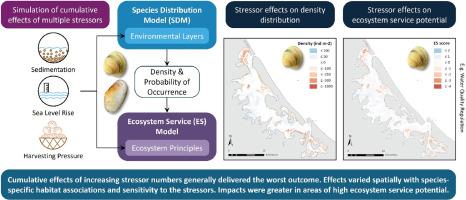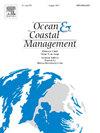Predicting the cumulative effects of multiple stressors on shellfish ecosystem service potential
IF 4.8
2区 环境科学与生态学
Q1 OCEANOGRAPHY
引用次数: 0
Abstract
Understanding and anticipating the effects of interacting stressors is critical for the effective management of marine ecosystems and the essential ecosystem services (ES) they provide. A key challenge in integrating cumulative effects and their impacts on ES delivery into spatial tools is to move beyond simple additive stressor interactions in the face of data scarcity, ecosystem complexity and uncertainty. Here we present a novel methodological approach with which to assess the cumulative effects of multiple stressors on the ES potential provided by two estuarine infaunal bivalves (Austrovenus stutchburyi and Paphies australis) which we illustrate in a case study within the Tauranga Harbour, New Zealand. We firstly assess the shift in density distribution and probability of occurrence in response to increasing sediment mud content, harvesting pressure and sea level rise. The single and cumulative effects of these stressors were simulated through species distribution models (SDM). Principle based models were then used to assess the translation of altered environmental conditions and shellfish abundance on the ES potential for food provision, water quality regulation, nitrogen removal and sediment stabilisation. The simulation of single and cumulative stressors at non-lethal levels were found to cause substantial changes to bivalve density and their distribution but could have both positive and negative impacts on ES potential due to shifts in optimal environmental conditions. Increasing the number of stressors delivered a worse outcome in terms of loss of density, particularly for Austrovenus with harvesting pressure being a common driver of decline in high density areas. This effect was similarly reflected in the ES predictions although there were nuances between the species related to habitat association and sensitivity to stressors. For example, the increase of sea level rise and mud had a greater negative impact on Austrovenus. Stressor effects varied spatially with some areas more heavily impacted than others and indicated an overall reduction of high ES areas whilst increasing areas of medium ES potential. This study introduces efficient and accessible means for integrating ES into cumulative effects assessments, the perspective from which renders the results more digestible for management. Using an interactive modelling approach rather than simple additive methods, it provides more robust information, aiding the prevention of ecological surprises. These quantitative spatial predictions will facilitate the identification of vulnerable areas, priority stressors and locations appropriate for restoration and conservation, assisting management in the rehabilitation and protection of bivalve beds and ES.

预测多种压力因素对贝类生态系统服务潜力的累积效应
了解和预测相互作用的压力源的影响对于有效管理海洋生态系统及其提供的基本生态系统服务(ES)至关重要。将累积效应及其对生态系统服务提供的影响整合到空间工具中的一个关键挑战是,在数据稀缺、生态系统复杂和不确定的情况下,如何超越简单的加法压力源相互作用。在此,我们提出了一种新颖的方法,用于评估多种压力因素对两种河口底栖双壳类动物(Austrovenus stutchburyi 和 Paphies australis)所提供的生态系统服务潜力的累积效应。我们首先评估了密度分布和出现概率在沉积物含泥量增加、捕捞压力和海平面上升情况下的变化。我们通过物种分布模型(SDM)模拟了这些压力因素的单一和累积效应。然后使用基于原理的模型来评估环境条件和贝类丰度的变化对食物供应、水质调节、脱氮和沉积物稳定等生态系统服务潜力的影响。在非致命水平上模拟单个和累积压力因素,发现它们会导致双壳贝类密度及其分布发生重大变化,但由于最佳环境条件的变化,它们对环境服务潜力既有积极影响,也有消极影响。压力因素数量的增加会导致密度下降,尤其是对奥氏双壳贝来说,采捕压力是导致高密度区域密度下降的常见原因。这种影响同样反映在生态系统服务预测中,尽管物种之间在生境关联性和对压力因素的敏感性方面存在细微差别。例如,海平面上升和淤泥的增加对奥氏海龟的负面影响更大。压力因素的影响在空间上各不相同,有些区域受到的影响比其他区域严重,这表明高ES区域总体上有所减少,而中等ES潜力的区域有所增加。这项研究引入了将生态系统服务纳入累积效应评估的高效、易用的方法,其视角使评估结果更易于管理。该研究采用交互式建模方法而非简单的相加方法,可提供更可靠的信息,有助于防止出现生态意外。这些定量空间预测将有助于确定脆弱区域、重点压力因素以及适合恢复和保护的地点,从而协助管理部门恢复和保护双壳贝床和 ES。
本文章由计算机程序翻译,如有差异,请以英文原文为准。
求助全文
约1分钟内获得全文
求助全文
来源期刊

Ocean & Coastal Management
环境科学-海洋学
CiteScore
8.50
自引率
15.20%
发文量
321
审稿时长
60 days
期刊介绍:
Ocean & Coastal Management is the leading international journal dedicated to the study of all aspects of ocean and coastal management from the global to local levels.
We publish rigorously peer-reviewed manuscripts from all disciplines, and inter-/trans-disciplinary and co-designed research, but all submissions must make clear the relevance to management and/or governance issues relevant to the sustainable development and conservation of oceans and coasts.
Comparative studies (from sub-national to trans-national cases, and other management / policy arenas) are encouraged, as are studies that critically assess current management practices and governance approaches. Submissions involving robust analysis, development of theory, and improvement of management practice are especially welcome.
 求助内容:
求助内容: 应助结果提醒方式:
应助结果提醒方式:


